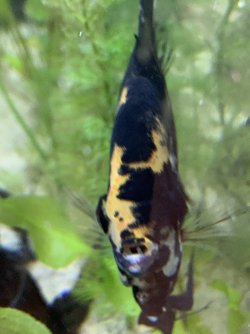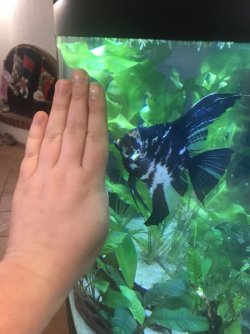It could be the start of mouth fungus (Columnaris, which is a bacterial infection even tho it's called mouth fungus) or a fat lip.
The fish also appears to have an infection in the mouth (red area between the mouth and eye).
Has anything new been added to the tank in the last 2 weeks?
How often are water changes and gravel cleans done?
How often is the filter cleaned?
How long has the tank been set up for?
I assume the ammonia, nitrite, nitrate and pH are fine?
------------------
Wipe the glass down.
Do a 75% water change and gravel clean every day for a week.
Make sure any new water is free of chlorine/ chloramine before it's added to the tank.
Clean the filter.
Increase aeration/ surface turbulence.
Add some salt.
If there's no improvement after a few days with salt, or if it gets worse in the next 24 hours, post more pictures immediately.
------------------
SALT
You can add rock salt (often sold as aquarium salt) or swimming pool salt to the aquarium at the dose rate of 1 heaped tablespoon per 20 litres of water. If there is no improvement after 48 hours you can double that dose rate so there is 2 heaped tablespoons of salt per 20 litres.
Keep the salt level like this for at least 2 weeks but no longer than 4 weeks otherwise kidney damage can occur. Kidney damage is more likely to occur in fish from soft water (tetras, Corydoras, angelfish, Bettas & gouramis, loaches) that are exposed to high levels of salt for an extended period of time, and is not an issue with livebearers, rainbowfish or other salt tolerant species.
The salt will not affect the beneficial filter bacteria, fish, plants, shrimp or snails.
After you use salt and the fish have recovered, you do a 10% water change each day for a week using only fresh water that has been dechlorinated. Then do a 20% water change each day for a week. Then you can do bigger water changes after that. This dilutes the salt out of the tank slowly so it doesn't harm the fish.
If you do water changes while using salt, you need to treat the new water with salt before adding it to the tank. This will keep the salt level stable in the tank and minimise stress on the fish.
When you first add salt, add the salt to a small bucket of tank water and dissolve the salt. Then slowly pour the salt water into the tank near the filter outlet. Add the salt over a couple of minutes.







